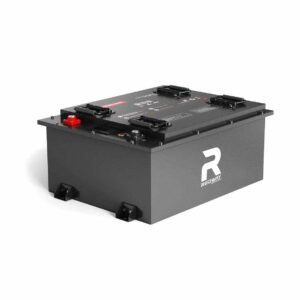What Are Marine RV Deep Cycle Batteries and How Do They Work?
Marine RV deep cycle batteries are designed to provide sustained power for marine vessels and recreational vehicles. Unlike starter batteries, they discharge slowly and recharge repeatedly, making them ideal for trolling motors, onboard electronics, and RV appliances. Their thick lead plates and robust construction ensure durability under deep discharge cycles.
How Do Marine RV Deep Cycle Batteries Differ from Regular Batteries?
Marine RV deep cycle batteries feature thicker lead plates and denser active material to withstand repeated deep discharges. Regular automotive batteries prioritize short bursts of high current for engine starting, while deep cycle variants deliver steady power over extended periods. Hybrid marine batteries combine cranking and deep cycle capabilities for dual-purpose use.

What Are the Key Features of High-Quality Marine RV Batteries?
Premium marine RV batteries include vibration-resistant construction, spill-proof designs, and advanced AGM (Absorbent Glass Mat) or gel technology. Look for high reserve capacity (RC), amp-hour (Ah) ratings matching your energy needs, and corrosion-resistant terminals. Lithium-ion models offer lighter weight and faster charging but at a higher upfront cost.
Which Maintenance Practices Extend Marine RV Battery Lifespan?
1. Keep terminals clean with baking soda/water mix
2. Maintain proper electrolyte levels in flooded batteries
3. Avoid discharging below 50% capacity
4. Use smart chargers with temperature compensation
5. Store fully charged in cool, dry environments
6. Equalize flooded batteries quarterly to prevent sulfation
How Does Temperature Affect Marine RV Battery Performance?
Extreme heat accelerates chemical reactions, increasing discharge rates but reducing overall lifespan. Cold temperatures thicken electrolyte, lowering capacity by 20-50% at 0°F. Ideal operating range is 50-85°F. Use battery heaters in freezing conditions and ventilated compartments in heat. Lithium batteries outperform lead-acid in temperature extremes, maintaining 80% capacity at -4°F.
| Battery Type | Capacity at 32°F | Capacity at 95°F |
|---|---|---|
| Flooded Lead-Acid | 70% | 85% |
| AGM | 75% | 90% |
| Lithium-Ion | 95% | 98% |
Temperature compensation becomes critical when charging in extreme environments. Lead-acid batteries require higher voltage in cold conditions (0.003V/°F/cell) and lower voltage in heat to prevent overcharging. Lithium batteries maintain more stable voltage profiles but still benefit from thermal management systems in harsh environments. Insulating battery compartments and using active cooling solutions can mitigate temperature-related performance drops.
What Safety Precautions Apply to Marine RV Battery Installation?
1. Install in vented, non-metallic battery boxes
2. Secure against movement with industrial-grade straps
3. Maintain 12″ clearance from fuel systems
4. Use marine-rated circuit breakers
5. Wear acid-resistant gloves when handling flooded batteries
6. Prevent sparks by connecting ground terminal last
How Do Charging Strategies Impact Battery Longevity?
Optimal charging uses 3-stage smart chargers (bulk/absorption/float) matched to battery chemistry. Lead-acid requires 14.4-14.8V absorption, lithium needs 14.6V. Avoid partial charging – lead-acid batteries require periodic full charges to prevent stratification. Equalize flooded batteries every 10 cycles. Lithium batteries prefer partial charges; full cycles count toward lifespan.
| Charging Parameter | Lead-Acid | Lithium-Ion |
|---|---|---|
| Bulk Charge Voltage | 14.4-14.8V | 14.2-14.6V |
| Float Voltage | 13.2-13.8V | 13.6V |
| Max Charge Current | 20% of Ah rating | 50% of Ah rating |
Advanced charging systems now incorporate adaptive algorithms that adjust parameters based on usage patterns. For marine applications, consider chargers with desulfation modes for lead-acid batteries and Bluetooth monitoring for lithium systems. Proper charging reduces plate corrosion in lead-acid batteries and prevents lithium cell imbalance. Always match charger output to battery bank capacity – undersized chargers cause incomplete charging, while oversized units risk terminal damage.
“Many users overlook state-of-charge monitoring. A quality battery monitor with shunt technology pays for itself in extended battery life. For marine applications, prioritize vibration resistance – we’re seeing 30% longer lifespans in AGM batteries compared to flooded in rough water conditions.”
— Marine Power Systems Engineer, 12+ years industry experience
FAQs
- How often should I replace my marine deep cycle battery?
- Typical lifespan: 4-6 years for AGM, 2-4 years for flooded lead-acid, 8-10+ years for lithium. Replace when capacity drops below 80% of rated Ah.
- Can I use automotive batteries in my RV/marine system?
- Not recommended. Automotive batteries can’t handle deep discharges – repeated use below 80% charge permanently damages them within 20-30 cycles.
- What’s the proper disposal method for old batteries?
- Return to authorized dealers or recycling centers. All 50 states require lead-acid battery recycling. Many retailers offer core charge refunds.
